Discrete time signals in Discrete MathematicsThe signals will be known as discrete-time signals if they are defined only at discrete intervals of time. With the help of symbol x[n], we can indicate the discrete-time signals, where n is used to indicate the independent variable in the time domain. In other words, we can use the signals of numbers to indicate the discrete-time signals, which are described as follows: Here n is used to indicate the integer, and x[n] is used to indicate the nth sample in the sequence. With the help of sampling continuous-time signals, we can often get discrete-time signals. In this type of case, the nth sample of the sequence and the analog signal's value xa(t) are both equal to each other at time t = nT: x[n] = xa(nT), -∞ < n < ∞ After that, the sampling period will be equal to T, and the sampling frequency will be determined like this: 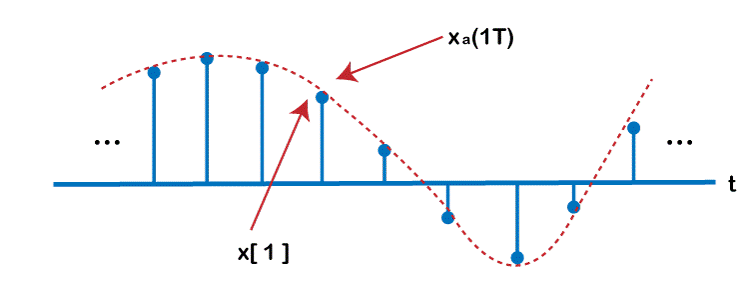
Because of the above reason, although x[n] is strictly known as an nth number in the sequence, but we can often refer to it as an nth sample. When we are talking about the entire sequence, then it can also be called "the sequence x[n]". In the graphical form, we can often depict the discrete-time signals in the following way: 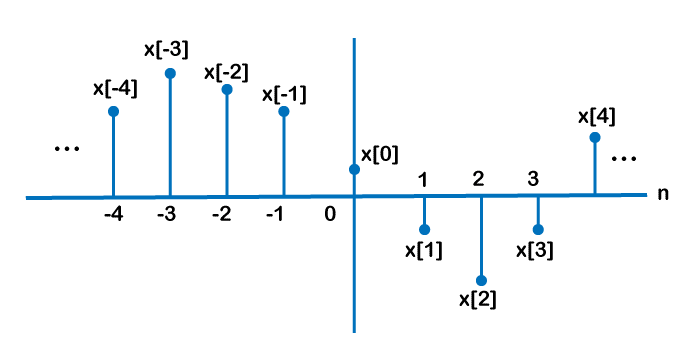
With the help of MATLAB function stem, we can plot the discrete-time signals. Here the value of x[n] is undefined for non-integer values of n. Representation of Discrete-time signals
Graphical representation of Discrete-time signal Here we will assume a discrete-time signal x(n) with some values, which are described as follows: x(0) = -1, x(-1) = 0, x(-2) = 3, x(-3) = -2, x(3) = 1, x(2) = 3, x(1) = 2 We can represent the discrete-time signal graphically in the following way: 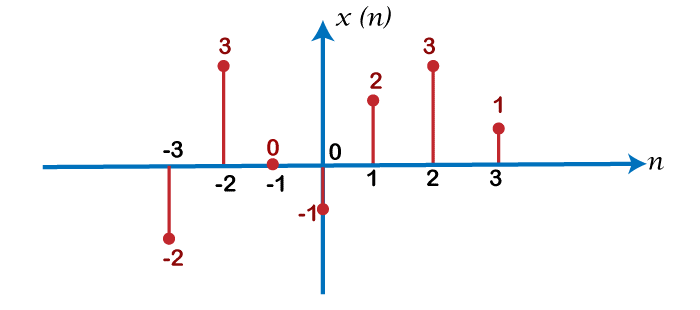
Functional representation of Discrete-time signal The magnitude of the signal will be written against the values of n in case of the functional representation of a discrete-time signal. Therefore, in the following way, we can represent the above discrete time signal x(n) with the help of functional representation like this: Tabular representation of Discrete-time signal In case of a tabular representation of discrete-time signal, we use the table to represent the sampling instant n and the magnitude of discrete-time signal at the corresponding sampling instant. In the following way, we can represent the above discrete time signal x(n) with the help of a tabular form like this:
Sequence representation of Discrete-time signal In the form of sequence representation, we can represent the discrete-time signal x[n] in the following way: Here The arrow mask (↑) is used to indicate the term corresponding to n = 0. If there is a case in which sequence representation of a discrete-time signal does not contain any arrow, then the first term of this sequence will correspond to n = 0. Sum and Product of Discrete time sequence With the help of adding the corresponding element of the sequence, we can get the sum of two discrete-time sequences, which is described as follows: With the help of multiplying the corresponding element of the sequence, we can get the product of two discrete-time sequences, which is described as follows: With the help of multiplying each element of the sequence and a constant, we can get the product of a sequence and a constant k, which is described as follows:
{Cn} = k{an} → Cn = kan
There are several ways in which we can manipulate the sequences. We can define the sum and product of two sequences, x[n] and y[n] with the help of respectively doing sample by sample sum and product. If we are multiplying x[n] by a, then it is similar to multiplying each sample value by a. Here y[n] will be known as the delayed or shifted version of x[n] if it contains the following: Y[n] = x[n-n0] Here n0 is used to indicate an integer. Unit sample SequenceThe unit sample sequence can be defined in the following way: 
The graphical representation of unit sample sequence is described as follows: 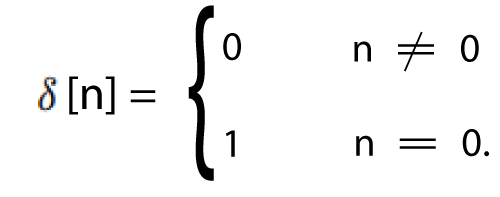
We can also call this type of sequence as an impulse or discrete time impulse. The Dirac delta function plays the same role in the case of discrete-time signals and in the case of continuous-time signals. That's why when we define the discrete-time signals, then it will not create any complications, and we can easily define them. The impulse sequence is used to have an important aspect, i.e., we can represent the arbitrary sequence in the form of a sum of scale and delayed impulse. For example: In the following way, we can represent the sequence: x[n] = a-4δ[n + 4] + a-3δ[n + 3] + a-2δ[n + 2] + a-1δ[n + 1] + a0δ[n] + a1δ[n - 1] + a2δ[n - 2] + a3δ[n - 3] + a4δ[n - 4] In general, we can use the following way to express any sequence: 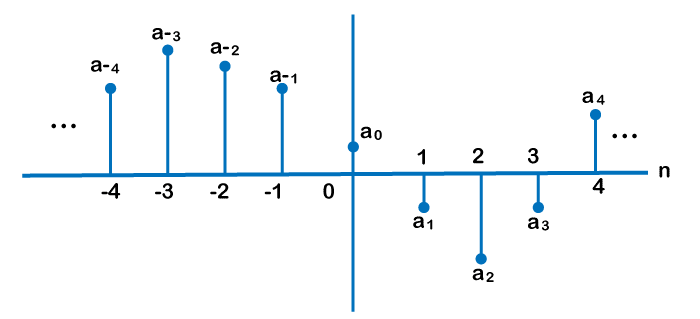
The unit sequence can be defined in the following way: 
The graphical representation to show unit sequence is described as follows: 
In the following way, the unit step can be related to the impulse: 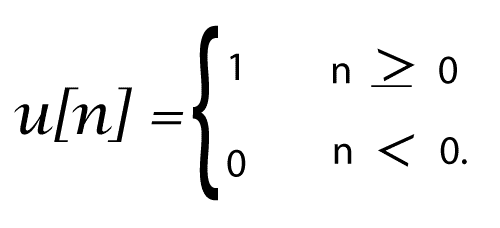
There is another way in which we can define it, which is described as follows: 
Conversely, we can express the unit sample sequence in the form of first backward difference of the unit step sequence like this: Exponential SequenceWe can analyze and represent the discrete-time systems with the help of Exponential sequences. The general form of this is described as follows: x[n] = Aαn If there are two real numbers, A and α, in this case, the sequence will be real. If A is positive and 0 < α < 1, in this case, the sequence value will be positive and decrease with increase n in the following way: 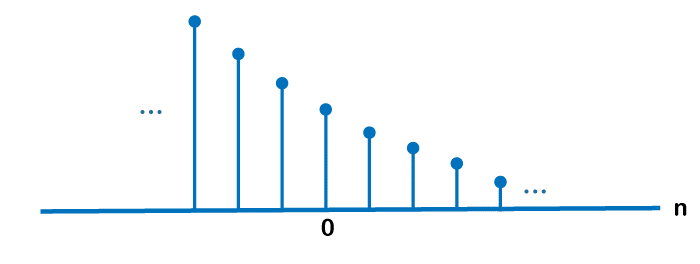
If there is a case where -1 < α < 0, then the sign of sequence will be alternate, but it will decrease in magnitude. If there is a case where |α| > 1, then n will be increased, and because of this, the sequence grows in magnitude. A sinusoidal sequence can be expressed in the following way: x[n] = A cos(w0n + φ) for all n, Here A and φ are used to indicate the real constants. The graphical representation of the sinusoidal sequence is described as follows: 
In the following way, we can express the exponential sequence Aαn with complex α = |α|ejw0 and A = |A|ejφ like this: So the real and imaginary parts are used to indicate the exponentially weighted sinusoids. The sequence will be known as the complex exponential sequence if |α| = 1, which is described as follows: x[n] = |A| ej(w0n + φ) = |A| cos (w0n + φ) + j |A| sin(w0n + φ) So this complex sinusoid is used to have the w0 frequency, and we can measure it in the form of radius per sample. So φ is the phase of a signal. The index n is always used to indicate an integer. Because of this, we can get some important differences between the properties of continuous-time complex exponentials and discrete-time complex exponential, which is described as follows: For this, we will assume a complex exponential with frequency (w0 + 2π) like this: x[n] = Aej(w0 + 2π)n = Aejw0n ej2π n = Aejw0n So in conclusion, we can say that the sequence for complex exponential, which has frequency w0, and the sequence for complex exponential, which have the frequency (w0+2π) are exactly similar. More generally, if there is a complex exponential sequence that has frequencies (w0+2π) are indistinguishable from one another, where r is used to indicate an integer. Similarly, for sinusoidal sequence, it will have the following: x[n] = A cos[(w0 + 2π r)n + φ] = A cos(w0n + φ) The complex exponential sequence and sinusoidal sequence are both always periodic in the case of continuous time. If the discrete-time sequences will be periodic if it contains the following: Thus, the discrete-time sinusoid will only have period if it contains the following: A cos[(w0n + φ] = A cos(w0n + w0N + φ) This sequence needs the following: We need the same conditions if we need to show that the complex exponential sequence C ejw0n is periodic. When we combine the above described two factors, then we will reach a conclusion that says that there will be N distinguishable frequencies only for which the corresponding sequences are periodic with period N. This type of set is described as follows: wk = 2π k/N, where k = 0, 1, 2, ...., N-1 Additionally, in the process of discrete-time sequences, we should modify the interpretation of high and low frequencies. If there is a discrete-time sinusoidal sequence x[n] = A cos[(w0n + φ], in this case, it will oscillate more rapidly because w0 increases from 0 to π, but in another case, the oscillation becomes slower because it increases further from π to 2π. 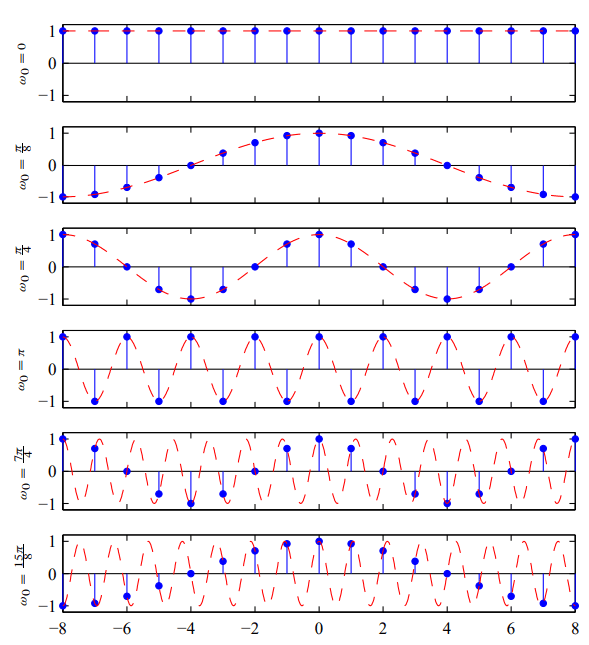
If there is a sequence that corresponds to w0 = 0, then it will be indistinguishable from that with w0 = 2π. In general, the frequencies will be referred to as low frequencies if there are frequencies in the vicinity of w0 = 2π k here, k is used to indicate the integer. In another case, if there are frequencies in the vicinity of w0 = (π + 2π k), then that type of frequency will be known as the high frequency.
Next TopicM-array Tree in Discrete Mathematics
|
 For Videos Join Our Youtube Channel: Join Now
For Videos Join Our Youtube Channel: Join Now
Feedback
- Send your Feedback to [email protected]
Help Others, Please Share









